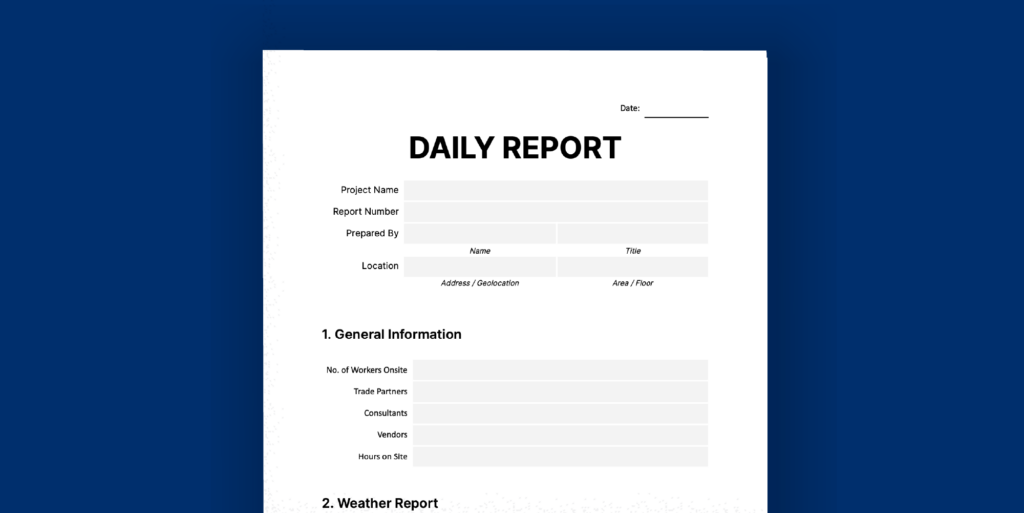— 9 min read
Construction Daily Reports: What to Include & Best Practices



Last Updated Jul 29, 2025

Bianca Holtier Coury
Education Audience Marketing
19 articles
Bianca Holtier Coury spent 15+ years in various roles managing construction projects, such as Preconstruction Team Lead, Purchasing Agent, and Project Manager. She has a wealth of experience in all project phases, including managing project schedules and budgets, bid management, and coordinating vendors and subcontractors. Bianca is an Associate Member of AIA and a LEED Green Associate. She currently serves as Director of Partnerships for the Construction Progress Coalition. Bianca holds a BA in Urban Design and Architecture Studies from NYU. She lives in Cleveland, OH.

Bob Hanes
Founder
15 articles
Bob Hanes is a professional writer and entrepreneur. He previously worked as a military sales and applications engineer for an aerospace firm, and cofounded a biotech company that creates drug screening solutions for the pharmaceutical industry. Bob has an MBA from the University of Buffalo in Logistics, Materials, and Supply Chain Management, and a BE in Mechanical Engineering. He is an avid Buffalo Bills fan.

Julia Tell
Contributing Writer
61 articles
Julia Tell is a freelance writer covering education, construction, healthcare, and digital transformation. She holds a Ph.D. in Media & Communications and has written for publications including Business Insider, GoodRx, and EdSurge, as well as nonprofits, international businesses, and educational institutions.
Last Updated Jul 29, 2025

Daily reports in the construction industry are an integral part of the daily workflow on a jobsite. Also called daily logs, daily reports serve as a recap of the day's events, capturing what occurred throughout the workday. This document provides a communication tool that helps mitigate risk by providing a comprehensive record of progress on construction projects.
This article looks into the components of construction daily reports, exploring what to include and who is involved in the reporting process. From general information to specific details, we'll provide a comprehensive look at what makes daily logs invaluable.
Table of contents
The Purpose of Daily Reporting
How teams use data from daily construction logs can impact the project's overall success. Making full use of daily reports allows companies to reap the benefits of the detailed information they contain. Here are the primary purposes of keeping daily logs:
- Tracking Progress: Maintaining up-to-date records provides accurate, timely information.
- Communication: Clear, detailed reports bridge the gap between stakeholders.
- Managing Resources: track materials, equipment and crew members for efficient use.
- Accountability and Transparency: Recording actions and responsibilities openly builds trust among stakeholders.
- Safety Management: Documenting hazards, incidents and near misses allows teams to mitigate site risks.
- Creating Historical Record: Logs can be used for dispute resolution or analyzed for future project planning.
- Data-informed Decisions: Real-time information fosters better decision-making.
- Supporting Compliance: Tracking can provide evidence of adherence to regulations.
Who writes daily construction reports?
The responsibility for creating daily reports falls on different individuals depending on the size and nature of the job. While site supervisors and project managers are commonly tasked with managing daily logs, other roles — such as assistant superintendents or project engineers — especially those involved in construction administration, may also take on this responsibility.
The Benefits of Daily Reports
As a central source of information during construction, daily logs are indispensable tools that improve team efficiency and provide the data necessary to monitor progress.
Accurate Records and Improved Communication
The details in the daily logs track activities, resources and progress that project teams can cross-check at any time. These reports also facilitate clear communication between on-site and off-site personnel, aiding in real-time decision-making.
Progress Tracking and Continuous Improvement
Daily reports can play a large role in improving operational efficiency. Companies can gauge project progress by continually analyzing daily reports to determine whether they are ahead or behind schedule. This consistent analysis offers insights into areas for improvement, helping companies refine their processes and enhance overall productivity.
Resource Management
Daily reports are pivotal not just from a project management perspective but also to address unforeseen financial impacts. Tracking inventory, hours worked and tool usage helps companies better manage their physical and human resources.
For instance, if there's a delay in equipment arrival or if materials delivered to the site are damaged, the daily report captures these details. Site supervisors may use this info to approve reordering the materials needed to complete the job.
Risk Mitigation
Accuracy in reporting is certainly about getting the facts right, but also about safeguarding the activities on the job site and reducing risks. Accurate logs provide a safety net, ensuring all activities are transparent and correctly documented to help planning and minimize delays. Daily reports often include any incident reports that need documentation, ensuring that safety protocols are adhered to and any mishaps are promptly addressed.
Legal Documentation
Daily construction logs can serve as evidence in case of disputes or legal issues. Tracking exactly when and how mistakes or overruns happened makes it easier to assign responsibility and settle matters.
What to Include in a Daily Report
The list of items to include may initially seem long, but when site personnel consider daily reports routine, it becomes a habit to make sure all information is correctly recorded.
General Information
The basic information is necessary for the daily construction report to be helpful for immediate and longer-term information needs.
Project Name
Use consistent naming conventions for report tracking and analysis.
Date and Report Number
Every daily report should clearly state the date and a unique report number for easy reference.
Preparer’s Name and Job Title:
This section should mention the name and designation of the individual who prepared the report.
Personnel On-site
It's essential to detail the trade partners present, any consultants or vendors that visited and the number of hours they spent on site. The headcount helps track crew, trade partners and other parties involved with the project.
Location
Apart from the geolocation, such as city and state, it's beneficial to specify the particular area of the project or building, especially if it's a large-scale project. For instance, mentioning the specific floor or section of a building can provide clarity to anyone reviewing the report.
Progress Photos
Including photos, especially those highlighting significant progress or issues, can visually communicate the day's events and provide a clearer picture of the situation on the ground.
Weather Conditions
Weather plays a significant role in construction activities. Documenting the day's environmental conditions can help understand the impact of weather on work activities and any potential delays or challenges it might have caused.
Work Activities
Tracking the work performed each day keeps team members on site and in the office updated on progress and work challenges.
Percentage Complete
Tracking the percentage of completion provides a snapshot of where the project stands in terms of its overall timeline.
Daily Activities
Detailing the tasks carried out on that day and those pending offers a clear picture of the day's achievements and the road ahead.
Work Currently in Progress
This section highlights ongoing tasks that may span multiple days.
Challenges
It's important to document any issues faced in the field, including any miscommunications, disputes between contractors or other general conflict and challenge observations.
Significant ilestones
Highlighting milestones, like the completion of framing or the commencement of exterior work, provides a sense of achievement and direction.
Materials and Equipment
Documenting deliveries and usage of materials and equipment helps make sure resources are tracked efficiently. This section can also touch upon inventory management, accounting for all equipment and materials and noting any damage that occurred during the day.
Explore data and trends for building materials prices.
Get the latest U.S. retail prices and view historical trends for common building materials.
Inspections
Documenting inspections is necessary for effective record-keeping. Differentiating between planned and unplanned inspections should be noted in the report. Sometimes inspections might be unexpected, and documenting them ensures that all activities are transparent and accounted for.
Safety Measures and Incidents
This section should detail any safety measures in place, including a PPE (Personal Protective Equipment) inventory checklist. Additionally, any injury reports or other safety-related documentation should be included so that safety protocols are maintained and adjusted as needed.
Budget & Resources Impact
The daily activities can have implications for the project's budget. Documenting these activities and their financial implications can help companies make sure the project remains within its budget.
Review & Sign Off
Knowing who reviews and approves the daily report allows any questions to be directed to the responsible team member. This section can also highlight the communication channels between the project executive and the site superintendent, ensuring that all parties are aligned.
Action Plan & Notes
Based on the day's report, outlining a course of action provides direction for the subsequent days, ensuring that the project stays on track and any issues are addressed promptly. This section can also include any important notes that don’t fit into other categories.
Best Practices for Daily Reports on Construction Sites
Implementing best practices can enhance the accuracy, clarity and overall usefulness of daily reports. When stakeholders receive timely and actionable information, it drives project success.
Use templates.
Standardizing a daily log template and processes for reporting streamlines communication from site leadership to subcontractors and everyone in between. Templates should be easily accessible and familiar to all stakeholders involved.
Free Download
Construction Daily Report Template
Download this simple, customizable daily log template to record common jobsite data.
- Free starter template
- Designed specifically for construction
- Trusted by construction professionals


Make logs consistent and timely.
Consistency in reporting goes beyond just the timing. Tracking the same parameters and metrics daily provides a clear and consistent picture of the project's progress. Creating checklists ahead of time and standardizing what needs to be captured each day means that reports are not left up to individual interpretation.
Focus on accuracy and clarity.
Capture and double-check all relevant details, and present them clearly and in simple language. Reports should be easy to understand, with specific details highlighted to make sure the reader can quickly grasp the day's events. Lowering the barrier to creating reports and making them straightforward helps make sure they are completed promptly, even if key personnel are too busy to complete them themselves.
Train key personnel.
One of the primary challenges workers face is understanding the importance and ingrained nature of daily reports in their operations. Is the daily report an afterthought or a key step in the standardized process? Daily logs are integral to the day-to-day activities, so adequately training team members on how to make daily reports on the construction site is necessary.
Companies can emphasize the importance of construction daily reports by making training a part of the onboarding process for site superintendents and other relevant personnel. This way, everyone knows what the reports are and how to access them — and it underscores their significance in the overall project management process.
Encourage input from all stakeholders.
Make sure site personnel feel comfortable contributing important data so the reports are complete and comprehensive. Although the site superintendent should be aware of everything that is happening, encouraging open communication for accurate documentation helps gather every relevant detail.
Digital vs. Paper Reports
Digital reporting solutions offer significant efficiency gains over legacy paper-based tracking, enabling real-time data entry, easy access and the ability to share information with stakeholders quickly. They reduce the risk of data loss and errors associated with manual entry, and often integrate seamlessly with other project management tools, streamlining workflows and enhancing productivity. Tracking and searching specific data is much easier when using electronic reporting.
On the other hand, traditional paper reports offer simplicity and do not require technical expertise or connectivity for electronic devices. However, they can be misplaced, are not easily shareable and can delay the dissemination of information. While digital tools offer greater efficiency and integration, paper reports are more effective than no daily logs in contexts where tech adoption is challenging.
Driving Construction Efficiency with Daily Report Data
In the complex world of construction, precision, accountability and communication are necessary. The data from daily reports is the backbone of effective project management and informed decision-making. By providing a real-time snapshot of a project's status, these reports build transparency and trust between stakeholders so potential issues are spotted and addressed promptly.
Was this article helpful?
Thank you for your submission.
86%
14%
You voted that this article was . Was this a mistake? If so, change your vote
Scroll less, learn more about construction.
Subscribe to The Blueprint, Procore’s construction newsletter, to get content from industry experts delivered straight to your inbox.
By clicking this button, you agree to our Privacy Notice and Terms of Service.
Thank you!
You’re signed up to receive The Blueprint newsletter from Procore. You can unsubscribe at any time.
Categories:
Written by

Bianca Holtier Coury
Education Audience Marketing | Autodesk
19 articles
Bianca Holtier Coury spent 15+ years in various roles managing construction projects, such as Preconstruction Team Lead, Purchasing Agent, and Project Manager. She has a wealth of experience in all project phases, including managing project schedules and budgets, bid management, and coordinating vendors and subcontractors. Bianca is an Associate Member of AIA and a LEED Green Associate. She currently serves as Director of Partnerships for the Construction Progress Coalition. Bianca holds a BA in Urban Design and Architecture Studies from NYU. She lives in Cleveland, OH.
View profile
Bob Hanes
Founder | Resonant Lab
15 articles
Bob Hanes is a professional writer and entrepreneur. He previously worked as a military sales and applications engineer for an aerospace firm, and cofounded a biotech company that creates drug screening solutions for the pharmaceutical industry. Bob has an MBA from the University of Buffalo in Logistics, Materials, and Supply Chain Management, and a BE in Mechanical Engineering. He is an avid Buffalo Bills fan.
View profile
Julia Tell
Contributing Writer | Procore Technologies
61 articles
Julia Tell is a freelance writer covering education, construction, healthcare, and digital transformation. She holds a Ph.D. in Media & Communications and has written for publications including Business Insider, GoodRx, and EdSurge, as well as nonprofits, international businesses, and educational institutions.
View profileExplore more helpful resources

How Close Are We to Bridging the Design-Build Divide?
For decades, construction decisions have often been made based on gut instinct. But what if the real barrier to transformation isn’t technology—it’s the divide between design and construction? In episode...

Construction Daily Report Template (Guide & Free Download)
Making progress on a construction project isn’t just about finishing the work: It’s also about documenting that work and communicating updates with the people who need to know. Keeping a...

Cost Reporting in Construction: Tracking a Project’s Financial Health
Knowing a construction project’s financial health can decide its success in an industry where projects are complex and budgets are tight. One of the top methods for attaining a project’s...

Construction Incident Report: Not Just For Injuries
Accidents happen, and even best-laid plans can go wrong. As the construction industry continues evolving rapidly to build faster than ever before, incidents can still occur on the most proactive...
Free Tools
Calculators
Use our calculators to estimate the cost of construction materials for your next project.
Templates
Find a template to help you with your construction project tasks.
Material Price Tracker
Get the latest U.S. retail prices and view historical trends for common building materials.
Glossary
Explore key terms and phrases used in the industry.
